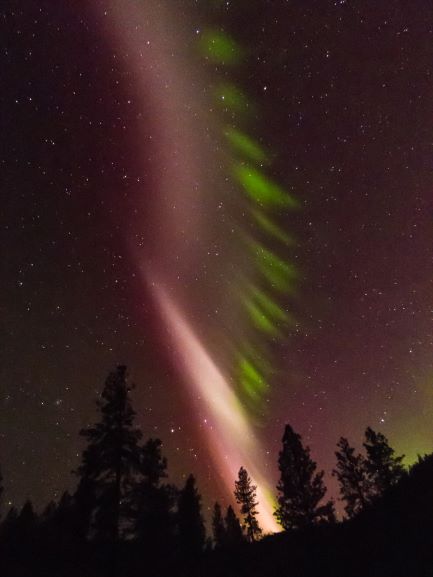That Weird, Aurora-Like Phenomenon Called STEVE Finally Has an Explanation

Scientists finally have an explanation for the weird celestial phenomenon called STEVE, which looks and behaves a lot like an aurora but has key differences.
A typical aurora — sometimes called the northern lights or the southern lights, depending on the hemisphere in which it's located — occurs when charged particles from the sun interact with Earth's oxygen and nitrogen molecules. This interaction excites the molecules and causes them to glow.
But STEVE, formally known as Strong Thermal Emission Velocity Enhancement, is different. In the Northern Hemisphere, the phenomenon is visible from areas farther south than a typical aurora, and it looks like a ribbon of pink or mauve light. Sometimes, STEVE even has a "picket fence" appearance, with green columns of light passing through the ribbon. Auroras, by contrast, usually are shimmering green ribbons.
Related: Help NASA Study 'Steve,' a Newfound Aurora Type
Now, new research on the phenomenon suggests that the picket-fence aspect of STEVE is caused by a similar mechanism as the process that results in an aurora. STEVE's mauve streaks occur when charged particles are heated up high in the atmosphere, further south than typical auroras. "This occurs outside the auroral zone, so it's indeed unique," Bea Gallardo-Lacourt, a space physicist at the University of Calgary in Alberta, Canada, and co-author of the new research, said in a statement released by the American Geophysical Union, which published the new research.
For a while, STEVE's origins were elusive. The phenomenon was discovered in 2016 by citizen scientists in western Canada. A 2018 study showed that its glow, unlike one leading hypothesis had proposed, does not result from charged particles falling into the atmosphere. The authors also pointed out that STEVE can show up at the same time as an aurora does, which makes it even harder to figure out which is which.
The new study examined satellite data gathered above STEVE events in April 2008 and May 2016. The measurements included information about Earth's magnetic and electrical fields in the magnetosphere, the region of Earth's atmosphere where the planet's magnetic field is stronger than any influence coming from the sun. Then, scientists compared the satellites' findings with amateur photos of STEVE taken from the ground at the same time.
Breaking space news, the latest updates on rocket launches, skywatching events and more!
When STEVE was on display, the study authors realized, energetic electrons were pouring into Earth's ionosphere, the layer of the planet's atmosphere where atoms lose electrons due to solar and cosmic radiation. The friction that flood creates heats particles, which creates the pinkish glow, almost like an incandescent light bulb.
Satellite information further revealed how the "picket fence" aspect of STEVE develops. The data revealed waves moving from Earth's magnetosphere to the ionosphere. In this region, the waves can both energize electrons and move them out of the magnetosphere, creating the picket-fence appearance, which happens simultaneously in the Northern and Southern hemispheres.
The science team said the new results will help them learn how to predict the paths of particles flowing through the ionosphere. It's an important field of study for scientists to better understand how these particles may interfere with radio communications and GPS signals. And it turns out, the public can help, as citizen scientists did by providing STEVE photographs for this research.
"As commercial cameras become more sensitive and increased excitement about the aurora spreads via social media, citizen scientists can act as a 'mobile sensor network,' and we are grateful to them for giving us data to analyze," lead author Toshi Nishimura, a space physicist at Boston University, said in the same statement.
A study based on the research was published April 16 in the journal Geophysical Research Letters.
- Astronaut Snaps 'Mind-Blowing' Aurora Picture from Space
- Amazing Auroras: Breathtaking Northern Lights Photos of 2015
- A 'Dragon Aurora' Appeared in the Sky Over Iceland, and NASA Is a Little Confused
Follow Elizabeth Howell on Twitter @howellspace. Follow us on Twitter @Spacedotcom and on Facebook.

Elizabeth Howell (she/her), Ph.D., was a staff writer in the spaceflight channel between 2022 and 2024 specializing in Canadian space news. She was contributing writer for Space.com for 10 years from 2012 to 2024. Elizabeth's reporting includes multiple exclusives with the White House, leading world coverage about a lost-and-found space tomato on the International Space Station, witnessing five human spaceflight launches on two continents, flying parabolic, working inside a spacesuit, and participating in a simulated Mars mission. Her latest book, "Why Am I Taller?" (ECW Press, 2022) is co-written with astronaut Dave Williams.
